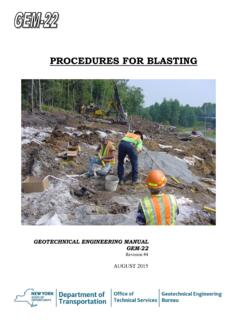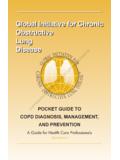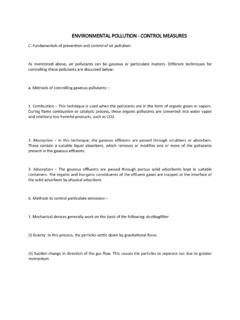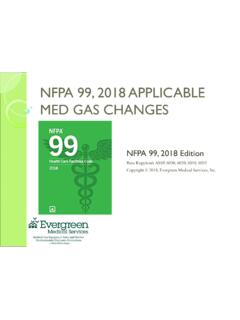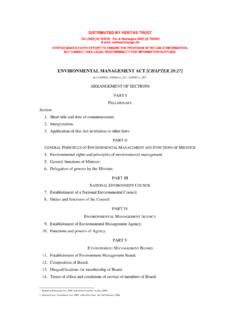Transcription of Safety Data Sheet: Copper - Wolverine Industries
1 Safety Data Sheet: Copper Section 1: Product Identification Manufacturer/Supplier: Recommended Use and Restrictions: Wolverine Tube, Inc. Solid Copper , various forms and uses. Manufacture of 2100 Market Street NE articles. Decatur, AL 35601. (800) 633-3972 Emergency Information: CHEMTREC (24HR Emergency Telephone), call: GHS Product Identifier: Copper 1-800-424-9300. Other Means of ID: Cu, Copper Dust, Copper Fume International CHEMTREC, call: 1-703-527-3887. Section 2: Hazard Identification Classification: Copper and Copper alloys are considered an article and are not hazardous in its solid form. However, certain processes such as cutting, milling, grinding, melting and welding could result in some serious hazardous materials being emitted. The GHS classification below pertains to these emitted products during these processes. Signal Word, Hazard Statements & Symbols: WARNING. Symbols Hazard GHS Classification Hazard Statements Causes damage to lungs, kidney and blood STOT (repeated exposure) Category 2.
2 Through prolonged or repeated exposure. Skin Irritation Category 2 Causes skin irritation. Acute Toxicity Inhalation Category 4 Harmful if inhaled. Acute Toxic to Aquatic Life Category 1 Very toxic to aquatic life. Very toxic to aquatic life with long lasting Chronic Toxic to Aquatic Life Category 1. effects. N/A Eye Irritation Category 2B Causes eye irritations. Notes: STOT Specific Target Organ Toxicity 1. Precautionary Statements Prevention: Do not breathe dust/fume/gas/vapor/spray. Use in a well-ventilated area. Avoid generating dust. Dusts and fines from processing may be ignitable. Use personal protective equipment as required. Wash thoroughly after handling. Do not eat, drink or smoke when using this product. Obtain special instructions before use. Do not handle until all Safety precautions have been read and understood. Contaminated work clothing should not be allowed out of the workplace. First Aid Response: EYES: Flush eyes with plenty of water for at least 15 minutes.
3 Seek medical attention if eye irritation persists. SKIN: Wash affected area with mild soap and water. Seek medical attention if skin irritation persists. INHALATION: Remove individual to fresh air. Check for clear airway, breathing and presence of pulse. If necessary administer CPR. Consult a physician immediately. INGESTION: Dust may irritate mouth and gastrointestinal tract. If ingested, seek medical attention. Storage: Store away from strong acids, alkalis and oxidizers. Store away from mercury, acetylene and halogens. Store in accordance with federal, state and local regulations. Disposal: Copper should be recycled whenever possible. Otherwise, dispose of in accordance with applicable federal, state and local regulations. Section 3: Composition and Information on Ingredients Composition: Name: CAS # % by Weight Copper 7440-50-8 100. Section 4: First Aid Measures Eye Contact: Check for and remove any contact lenses. Do not use eye ointment.
4 Seek medical attention immediately. Skin Contact: After contact with skin, wash immediately with plenty of water. Gently and thoroughly was the contaminated skin with running water and non-abrasive soap. Be particularly careful to clean folds, crevices, creases and groin. Cover the irritated skin with an emollient (moisturizing cream or lotion). If irritation persists, seek medical attention. Wash contaminated clothing before reusing. Inhalation: Allow the victim to rest in a well ventilated area. Seek immediate medical attention. Ingestion: Do not induce vomiting. Loosen tight clothing such as a collar, tie, belt or waistband. If the victim is not breathing, perform mouth-to-mouth resuscitation. Seek immediate medical attention. Important Symptoms and Effects: Copper and Copper alloys as sold and shipped is not likely to present acute or chronic health effects. However, during processing (cutting, milling, grinding, melting or welding) emitted byproducts may cause irritations, difficulty breathing, coughing or wheezing.
5 May cause allergic skin reactions. 2. Section 5: Fire and Explosion Data Suitable Extinguishing Media: Non-flammable. Not applicable for solid product. Use Class D extinguishing agents or sand on fires involving dusts or fines. Use extinguishers appropriate for surrounding materials. DO NOT use water on molten metal. DO NOT use water on dust, powder or fume fires. Specific Hazards: Dusts from grinding operations may burn if they are ignited. Dust, powder and fumes are flammable when exposed to flame or by chemical reaction with oxidizing agents. Hazardous Combustion Products: At temperatures above the melting point, fumes containing Copper oxides and smaller amounts of other alloying elements (if present) may be liberated. Special Protective Equipment and Precautions for Firefighters: Firefighters should wear self-contained NIOSH- approved breathing apparatus and full protective clothing. Explosion Data: Molten metal in contact with water may be explosive.
6 Section 6: Accidental Release Measures Personal Precautions, PPE and Emergency Procedures: Not applicable to Copper in solid state. Avoid dust formation. Ensure adequate ventilation. Clean-up personnel should be protected against contact with eyes and skin protection. Environmental Precautions: Not applicable to Copper in solid state. Do not flush into surface water or sanitary sewer system. Methods and Materials for Containment and Clean-up: Solid metal does not pose any problems. Dust spills should be cleaned up avoiding dust generation. Wash down with water if in contact with acids. Avoid inhalation of dusts. Collect scrap Copper for recycling. Section 7: Handling and Storage Precautions: Keep away from heat. Keep away from sources of ignition. Empty containers pose a fire risk, evaporate the residue under a fume hood. Ground all equipment containing material. Do not breathe dust. Avoid contact with eyes. Wear suitable protective clothing.
7 In case of insufficient ventilation, wear suitable respiratory equipment. If you feel unwell, seek medical attention and show the label when possible. Storage: Keep container dry. Keep in a cool place. Ground all equipment containing material. Keep container tightly closed. Keep in a cool well-ventilated place. Incompatibilities: Combustible materials should be stored away from extreme heat and away from strong oxidizing agents. 3. Section 8: Exposure Controls and Personal Protection Control Parameters: The exposure limit for Copper dusts and fumes has been established as follows in the table below. All OEL values are established as 8-hour Time Weighted Average (TWA) concentrations unless otherwise noted. Chemical Name CAS Number OSHA PEL ACGIH TLV NIOSH REL. 1 mg/m3 (dust) 1 mg/m3 (dust) 1 mg/m3 (dust). Copper 7440-50-8. mg/m3 (fume) mg/m3 (fume) mg/m3 (fume). Appropriate Engineering Controls: Provide general or local exhaust ventilation to minimize airborne concentrations during milling, grinding, melting and welding operations.
8 Individual Protective Measures: Dependent upon process being performed on material. Each operation must be addressed for suitable equipment. Gloves: As required. Clothing: N/A. Eyes: Safety glasses or goggles. Footwear: N/A. Respirator: If concentrations exceed established limits use NIOSH/MSHA approved particulate respirator when generating dust or fume. Other: With molten metal, use full body cover clothing suitably treated to prevent burns. Section 9: Chemical and Physical Properties Physical State: Solid Other Information: Not Applicable Odor: Not Applicable Appearance: Reddish metallic solid pH: Not Applicable Odor Threshold: Not Applicable Boiling Point: 2595 C (4703 F) Melting Point: 1083 C (1981 F). Evaporation Rate: Not Applicable Flash Point: N/A. UFL%: Not Applicable Flammability Not Flammable Vapor Pressure: Not Applicable LFL%: Not Applicable Relative Density: Vapor Density: Not Applicable Solubility: Not Soluble Specific Gravity: No Data Auto-Ignition Temp: Not Applicable Partition Coefficient: No Data Viscosity: Not Applicable Decomposition Temperature: No Data Section 10: Stability and Reactivity Data Stability: The product is stable.
9 Copper and its alloys are stable under normal storage and handling conditions. Possibility of Hazardous Reactions: Hazardous polymerization cannot occur. Conditions to Avoid: Reacts violently with hydrogen peroxide and other oxidizers. Reaction with acids could produce noxious gases. In contact with acids, hydrogen gas may evolve. Avoid dust formation. Molten metal can react violently with water or moisture. Incompatible Materials: Yes, strong acids, alkalis and oxidizers. Also, mercury, acetylene and halogens. Hazardous Decomposition: None. 4. Section 11: Toxicological Data LD50 Oral: No Data LD50 Dermal: No Data LD50 Inhalation: No Data Other: No Data Likely Routes of Entry: None for Copper and alloys in their natural solid form. Inhalation of metal particulate or elemental oxide fumes generated during welding, burning, grinding or machining may pose acute or chronic health effects. In finely divided form, skin contact may produce localized irritation and/or contact dermatitis.
10 Eyes: High concentrations of dust may cause irritation to the eyes. Fumes can cause eye irritation. Skin: May cause skin irritations. Prolonged skin contact with coated Copper may cause skin irritation in sensitive individuals. Workers with anemia, kidney damage, digestive, respiratory, nervous system, pregnant women and fertile females warrant particular attention. Inhalation: Dust may irritate the nose and throat. If heated, Copper fumes may cause metal fume fever, a delayed, benign, transient flu-like condition. Symptoms related to Product Characteristics: None for Copper and alloys in their natural solid state. Effects of Acute Exposure to Material: Can cause metal fume fever, a metallic taste in the mouth, dryness or irritation of the throat, and coughing. After 4-48 hours symptoms can include sweating, shivering, headache, fever, muscle aches, nausea, vomiting, weakness and tiredness. STOT (Single Exposure): Causes damage to organs (kidneys, respiratory system).

